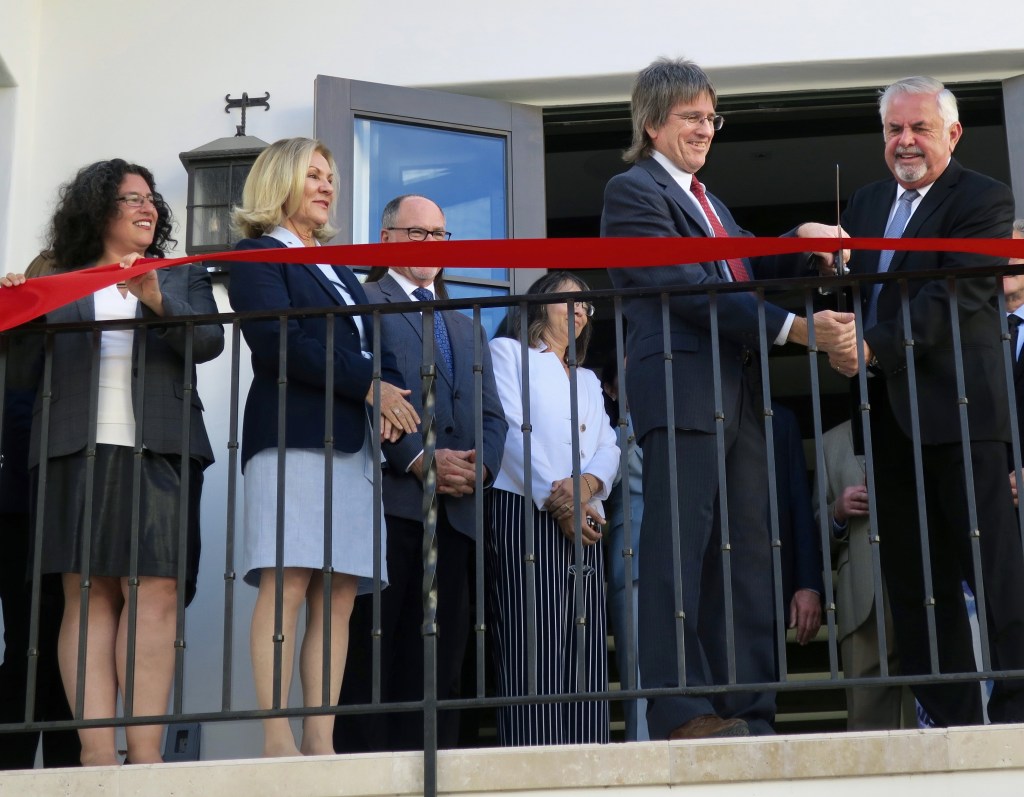
Last Thursday, the long-delayed and much-disputed building across the street from the Montecito Inn held its grand opening. The site of the former 1950s-style Union 76 gas station at the corner of Coast Village and Olive Mill roads is now a swanky three-story mixed-use development. Five residences — called the Villas at Olive Mill — sit atop Folded Hills’s Montecito tasting room, Heather James Fine Art, and Village Properties Realtors.
After submitting the initial application in 2004, owners John Price and Tod Berlinger had their patience tested by 28 hearings and four lawsuits before getting the final green light in 2017. John Price is the founder and president of Price Management, which owns gas stations and car washes in the Santa Barbara area, and Berlinger is the company’s CFO.
About 250 guests attended the opening bash, including almost every elected official in the city and county. Addressing the crowd from the balcony of one of the tiny units was former mayor Helene Schneider, who acknowledged the project’s long and winding road and lauded Price and his wife, Janna, for their vision, persistence, and grace in creating a “beautiful gateway into Santa Barbara and Montecito.”
No expense was spared in the five villas, which range in size from 2,200 to 3,300 square feet and are priced from mid $3 million to high $5 million. Former Dallas Cowboys quarterback Troy Aikman has already purchased one.
The owners of Folded Hills Winery — Kim and Andy Busch (of Anheuser-Busch) — created a tasting room designed to give guests “a little flavor of ranch living” and be enticed to “come visit the estate, taste wine, feed and pet baby pigs, goats, donkeys, and even take selfies with the Clydesdales,” said Kim. The Buschs had their first vintage in 2015, which was from purchased Ballard Canyon grapes.
Heather James Fine Art has the 2,000-square-foot corner spot, where it will host a cross-section of impressionist, modern, post-war, contemporary, Latin American, and old master works. Highlights currently on display are pieces by Claude Monet, Edward Hopper, Andy Warhol, Robert Indiana, and Roy Lichtenstein.
Conspicuous by his absence at the opening was Texas billionaire and one time Santa Barbara resident Randall Van Wolfswinkel, who in 2009 was so enraged by Price’s proposed development that he spent more than $520,000 trying to get a brand-new Santa Barbara City Council elected. By the standards of council elections, Van Wolfswinkel and his money loomed over the political landscape, promoting the candidacies of conservative Republicans and old-school slow-growthers.
Part and parcel of the same uprising, Van Wolfswinkel spent lavishly on a ballot measure that would lower the maximum building height in Santa Barbara. Then-mayoral candidate Schneider managed to weather Van Wolfswinkel’s financial onslaught to win election over her most threatening rival, Dale Francisco, then the arch wizard of conservative politics in Santa Barbara.
As a person, Van Wolfswinkel flew far below the radar. He was allegedly upset by the pace and scale of development then taking place and looked askance at Price’s proposal to convert the Union 76 gas station into high-end housing. On Santa Barbara’s political chessboard, Price ranks as a knight or a bishop, one of those low-key characters, personally conservative, who seem to know everyone and donate both loyally and strategically to candidates of all ideological stripes.
Although Van Wolfswinkel ultimately failed in this power grab, it did have lasting consequences. Though Francisco lost in his mayoral bid, he retained his council seat. He would be joined on the dais by similarly minded conservatives Michael Self and Frank Hotchkiss. And although the building height measure went down to defeat, it too remains consequential. It marked the emergence of the Republican NIMBY, an anomalous but persistent element of Santa Barbara politics.




You must be logged in to post a comment.